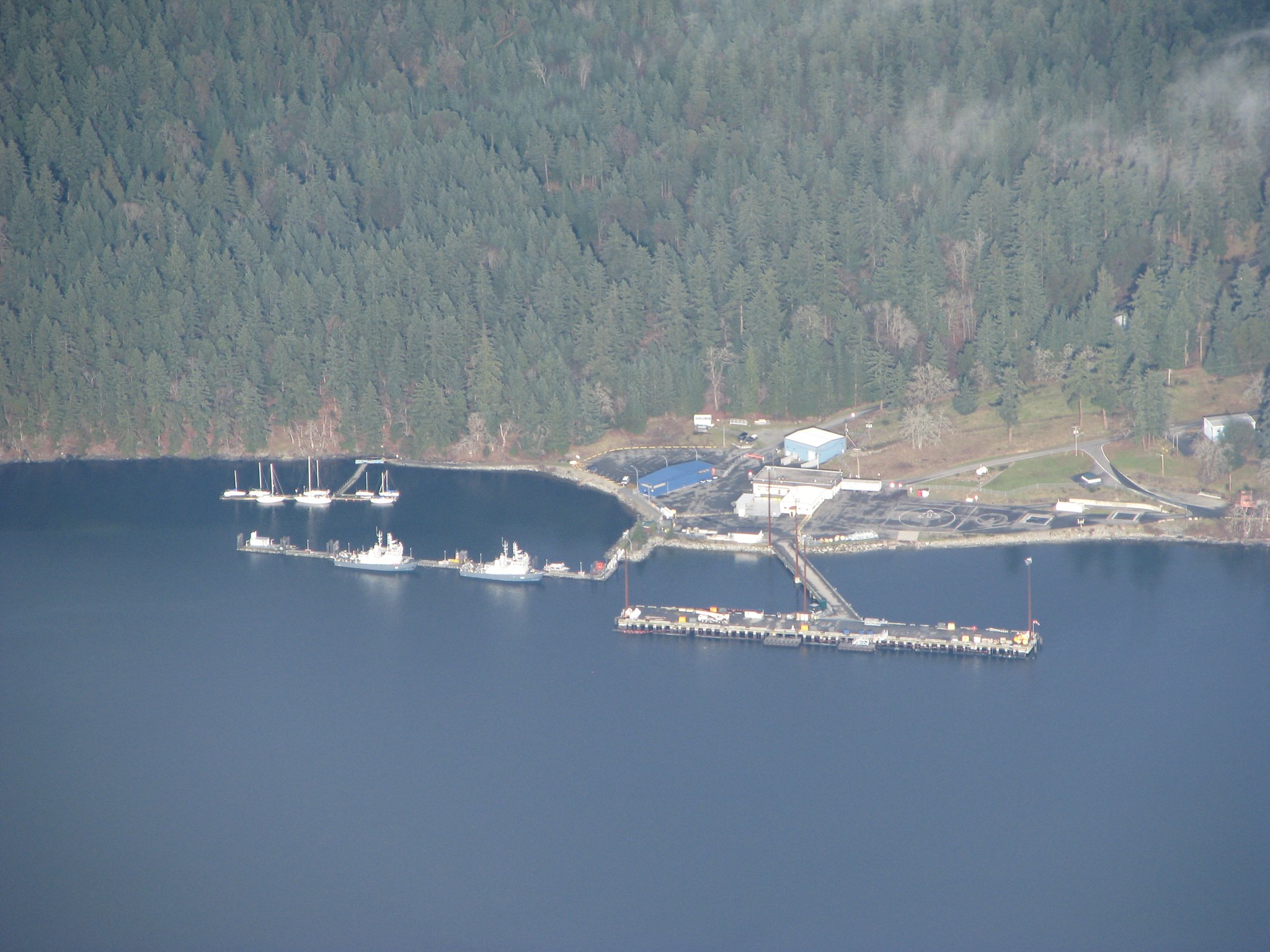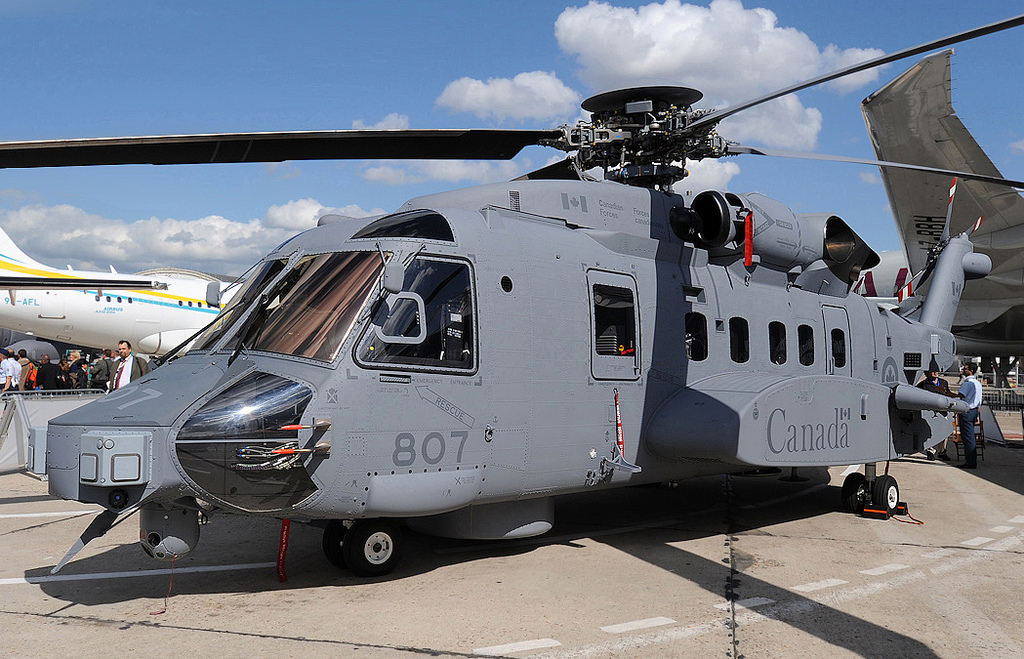|
CFMETR, Nanoose Bay
The Canadian Forces Maritime Experimental and Test Ranges (CFMETR) is a maritime test facility located on the east side of Vancouver Island, at Nanoose Bay. The ranges operated by CFMETR are located over an area of the Strait of Georgia—known as Area WG—that is several hundred metres deep, several dozen kilometres long and several kilometres wide over a seabed composed of soft mud and free of underwater obstacles. The facility employs a three-dimensional sonar tracking system for monitoring the performance and position of objects in these waters for real-time tracking. During periods of activity, the range area is closed off from all civilian maritime traffic as a safety measure. Equipment tested at the facility consists of a variety of devices, including sonobuoys, sonar systems (ship and aircraft), torpedoes and the repair and overhaul of the dipping sonar used on Canada's Sikorsky CH-148 Cyclone helicopter fleet. No explosives are used. This facility is unique ... [...More Info...] [...Related Items...] OR: [Wikipedia] [Google] [Baidu] |
Vancouver Island
Vancouver Island is an island in the northeastern Pacific Ocean and part of the Canadian Provinces and territories of Canada, province of British Columbia. The island is in length, in width at its widest point, and in total area, while are of land. The island is the largest by area and the most populous along the west coasts of the Americas. The southern part of Vancouver Island and some of the nearby Gulf Islands are the only parts of British Columbia or Western Canada to lie south of the 49th parallel north, 49th parallel. This area has one of the warmest climates in Canada, and since the mid-1990s has been mild enough in a few areas to grow Mediterranean Sea, Mediterranean crops such as olives and lemons. The population of Vancouver Island was 864,864 as of 2021. Nearly half of that population (~400,000) live in the metropolitan area of Greater Victoria, the capital city of British Columbia. Other notable cities and towns on Vancouver Island include Nanaimo, Port Alberni, ... [...More Info...] [...Related Items...] OR: [Wikipedia] [Google] [Baidu] |
Royal Canadian Navy
The Royal Canadian Navy (RCN; french: Marine royale canadienne, ''MRC'') is the Navy, naval force of Canada. The RCN is one of three environmental commands within the Canadian Armed Forces. As of 2021, the RCN operates 12 frigates, four attack submarines, 12 coastal defence vessels, eight patrol class training vessels, two offshore patrol vessels, and several auxiliary vessels. The RCN consists of 8,570 Regular Force and 4,111 Primary Reserve sailors, supported by 3,800 civilians. Vice-Admiral Angus Topshee is the current commander of the Royal Canadian Navy and chief of the Naval Staff. Origins of the Royal Canadian Navy, Founded in 1910 as the Naval Service of Canada (French: ''Service naval du Canada'') and given royal sanction on 29 August 1911, the RCN was amalgamated with the Royal Canadian Air Force and the Canadian Army to form the Unification of the Canadian Forces, unified Canadian Armed Forces in 1968, after which it was known as Maritime Command (French: ''Commandemen ... [...More Info...] [...Related Items...] OR: [Wikipedia] [Google] [Baidu] |
Ottawa
Ottawa (, ; Canadian French: ) is the capital city of Canada. It is located at the confluence of the Ottawa River and the Rideau River in the southern portion of the province of Ontario. Ottawa borders Gatineau, Quebec, and forms the core of the Ottawa–Gatineau census metropolitan area (CMA) and the National Capital Region (NCR). Ottawa had a city population of 1,017,449 and a metropolitan population of 1,488,307, making it the fourth-largest city and fourth-largest metropolitan area in Canada. Ottawa is the political centre of Canada and headquarters to the federal government. The city houses numerous foreign embassies, key buildings, organizations, and institutions of Canada's government, including the Parliament of Canada, the Supreme Court, the residence of Canada's viceroy, and Office of the Prime Minister. Founded in 1826 as Bytown, and incorporated as Ottawa in 1855, its original boundaries were expanded through numerous annexations and were ultimately ... [...More Info...] [...Related Items...] OR: [Wikipedia] [Google] [Baidu] |
British Columbia
British Columbia (commonly abbreviated as BC) is the westernmost province of Canada, situated between the Pacific Ocean and the Rocky Mountains. It has a diverse geography, with rugged landscapes that include rocky coastlines, sandy beaches, forests, lakes, mountains, inland deserts and grassy plains, and borders the province of Alberta to the east and the Yukon and Northwest Territories to the north. With an estimated population of 5.3million as of 2022, it is Canada's third-most populous province. The capital of British Columbia is Victoria and its largest city is Vancouver. Vancouver is the third-largest metropolitan area in Canada; the 2021 census recorded 2.6million people in Metro Vancouver. The first known human inhabitants of the area settled in British Columbia at least 10,000 years ago. Such groups include the Coast Salish, Tsilhqotʼin, and Haida peoples, among many others. One of the earliest British settlements in the area was Fort Victoria, established ... [...More Info...] [...Related Items...] OR: [Wikipedia] [Google] [Baidu] |
Glen Clark
Glen David Clark (born November 22, 1957) is a Canadian business executive and former politician who served as the 31st premier of British Columbia from 1996 to 1999. Early life and education Clark attended independent Roman Catholic schools, namely St. Jude’s Elementary and Notre Dame Secondary in East Vancouver. At Notre Dame, Clark was known as a small, fearless linebacker for the football team. He was also student council president and played the lead male role in ''The Sound of Music'' and later performed in ''South Pacific''. Clark received a bachelor's degree from Simon Fraser University and a master's degree from the University of British Columbia. Before entering politics, he was part of the labour movement and worked as a natural resource policy consultant.. Premier of British Columbia Clark was first elected to the Legislative Assembly of British Columbia in the 1986 provincial election. He served as the Minister of Finance and Corporate Relations and then as the ... [...More Info...] [...Related Items...] OR: [Wikipedia] [Google] [Baidu] |
Alaskan Salmon War
The Pacific Salmon War was a period of heightened tensions between Canada and the United States over the Pacific Salmon catch. It began in 1992 after the first Pacific Salmon Treaty, which had been ratified in 1985, expired, and lasted until a new agreement was signed in 1999. Disagreements were high in 1994, when a transit fee was set on American fishing vessels using the Inside Passage and a ferry was blockaded by fishing boats in Friday Harbor, Washington. Tensions peaked in 1997, when Canadian fishers, pursuing a "Canada First" strategy, began catching as many salmon as they could. After aggressive tacks on both sides, Alaskan fishers were granted free rein to fish for 56 hours around Noyes Island. In retaliation, a flotilla consisting of between 100 and 200 Canadian fishing boats surrounded the Alaskan ferry MV ''Malaspina'' in the port of Prince Rupert, British Columbia, for three days. Heightened tensions continued for the rest of the fishing season, with Premier Glen Clar ... [...More Info...] [...Related Items...] OR: [Wikipedia] [Google] [Baidu] |
Department Of National Defence Headquarters (Canada)
National Defence Headquarters (NDHQ) ( French: ''Quartiers généraux de la Défense nationale'' (''QGDN'')) was created through the integration of Canadian Armed Forces Headquarters (CAF HQ) with the civilian Department of National Defence (DND) staff in October of 1972. NDHQ is not a specific location, but is instead housed throughout a collection of offices in buildings across the National Capital Region, although it is most commonly identified with the Major-General George R Pearkes Building on Colonel By Drive in Ottawa. From 2017, various locations have been consolidating at National Defence Headquarters, Carling Campus on Carling Avenue. History During the Cold War, the threat of nuclear attack on the National Capital Region saw an Emergency Government Headquarters constructed 30 km west of Ottawa at CFS Carp; this facility was to house a scaled-down NDHQ, along with the federal cabinet and other political, military and government leaders. Completed in 1974, th ... [...More Info...] [...Related Items...] OR: [Wikipedia] [Google] [Baidu] |
Naval Base Kitsap
Naval Base Kitsap is a U.S. Navy base located on the Kitsap Peninsula in Washington state, created in 2004 by merging the former Naval Station Bremerton with Naval Submarine Base Bangor. It is the home base for the Navy’s fleet throughout West Puget Sound, provides base operating services, support for both surface ships and fleet ballistic missile and other nuclear submarines as one of the U.S. Navy's four nuclear shipyards, one of two strategic nuclear weapons facilities, and the only West Coast dry dock capable of handling a ''Nimitz''-class aircraft carrier and the Navy's largest fuel depot. Naval Base Kitsap is the third-largest Navy base in the U.S. It also provides service, programs, and facilities for their hosted combat commands, tenant activities, ships' crews, and civilian employees. It is the largest naval organization in Navy Region Northwest, and composed of installations at Bremerton, Bangor, Indian Island, Manchester, and Keyport, Washington. It received the ... [...More Info...] [...Related Items...] OR: [Wikipedia] [Google] [Baidu] |
Department Of National Defence (Canada)
The Department of National Defence (DND; french: Ministère de la Défense nationale) is the department of the Government of Canada which supports the Canadian Armed Forces in its role of defending Canadian national interests domestically and internationally. The department is a civilian organization, part of the public service, and supports the armed forces; however, as a civilian organization is separate and not part of the military itself. National Defence is the largest department of the Government of Canada in terms of budget, and it is the department with the largest number of buildings (6,806 in 2015). The department is responsible to Parliament through the minister of national defence Anita Anand . The deputy minister of National Defence, the senior most civil servant within the department, is responsible for the day-to-day leadership and operations of the department and reports directly to the minister. The department exists to aid the minister in carrying out their ... [...More Info...] [...Related Items...] OR: [Wikipedia] [Google] [Baidu] |
Sikorsky CH-148 Cyclone
The Sikorsky CH-148 Cyclone is a twin-engine, multi-role shipboard helicopter developed by the Sikorsky Aircraft Corporation for the Canadian Armed Forces. A military variant of the Sikorsky S-92, the CH-148 is designed for shipboard operations and replaced the venerable CH-124 Sea King, which was in operation from 1963 to 2018. The search for a Sea King replacement began in the 1980s. The Cyclone is operational with the Royal Canadian Air Force (RCAF) as of 2018 and is to conduct anti-submarine warfare (ASW), surveillance, and search and rescue missions from Royal Canadian Navy warships. The helicopter is also to provide tactical transport for operations supporting national and international security efforts. In 2004, Canada awarded Sikorsky Aircraft a contract for 28 CH-148s with deliveries planned to start in 2009. Deliveries were repeatedly delayed due to development issues and difficulty fulfilling contract requirements; the first deliveries, involving six initial helicopte ... [...More Info...] [...Related Items...] OR: [Wikipedia] [Google] [Baidu] |
Torpedo
A modern torpedo is an underwater ranged weapon launched above or below the water surface, self-propelled towards a target, and with an explosive warhead designed to detonate either on contact with or in proximity to the target. Historically, such a device was called an automotive, automobile, locomotive, or fish torpedo; colloquially a ''fish''. The term ''torpedo'' originally applied to a variety of devices, most of which would today be called naval mine, mines. From about 1900, ''torpedo'' has been used strictly to designate a self-propelled underwater explosive device. While the 19th-century battleship had evolved primarily with a view to engagements between armored warships with naval artillery, large-caliber guns, the invention and refinement of torpedoes from the 1860s onwards allowed small torpedo boats and other lighter surface combatant , surface vessels, submarines/submersibles, even improvised fishing boats or frogmen, and later light aircraft, to destroy large shi ... [...More Info...] [...Related Items...] OR: [Wikipedia] [Google] [Baidu] |







